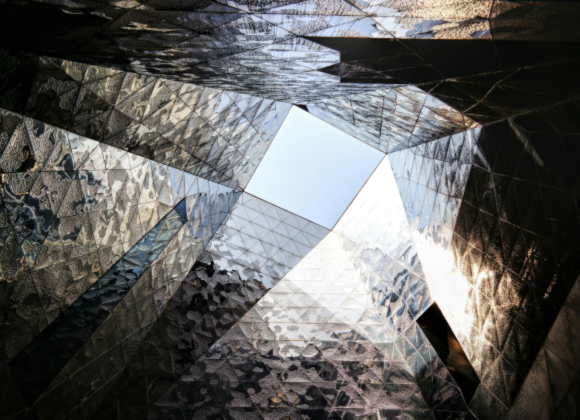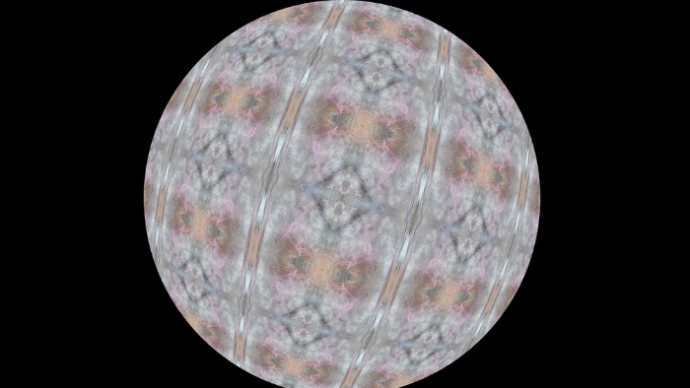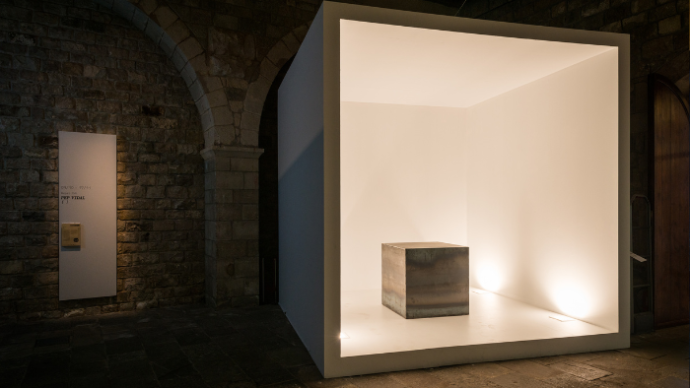The Biennial's permanent exhibitions invite you to rethink the limits of perception, matter and technology
From 18 to 23 November, as part of the City and Science Biennial 2025, the Born Museum of History in Barcelona will host a series of permanent exhibitions that can be visited throughout the week (also during Science Night). These are proposals that combine scientific research and artistic creation to reflect on issues such as emptiness, uncertainty, matter or the relationship between technology and nature.
The installations, created by artists and collaborators from disciplines such as physics, philosophy or digital arts, turn the city into an open laboratory of perception and thought. Through materials, sounds, lights and immersive spaces, the public is invited to experience concepts specific to frontier research, one of the central axes of the Biennial, from a poetic and sensory perspective.
Physicist and artist Pep Vidal proposes a conceptual and scientific sculpture that turns “nothing” into tangible matter. His piece, titled { }, is an 83-centimeter cube weighing almost a ton that contains an ultra-vacuum capsule inside: a space where atmospheric pressure is extremely low and physical interactions practically disappear.
The creation process involved highly precise scientific procedures and high-tech materials to achieve an almost perfect degree of vacuum. The work thus transforms absence into presence, showing the fragility of systems and the complexity of their relationships.
Quantum Chaos Set
Australian artist Paul Thomas, in collaboration with Jan Andruszkiewicz, presents a work that translates the idea of quantum chaos into the visual and sound fields. Using real data and scientific simulations, Quantum Chaos Set explores how uncertainty and phenomena in the quantum world have transformed our cultural perception of the classical world.
The installation creates a liminal and immersive space, where the boundaries between science, art and philosophy dissolve, and where the audience can physically experience the ambiguity of knowledge. The work does not offer answers, but a feeling of constant oscillation, like the very behavior of the subatomic particles it represents.
Urbetrònica
Urbetrònica In a historical moment dominated by algorithmic precision, artist Marie-France Veyrat reclaims error as a source of expression and knowledge. Urbetrònica is an audiovisual installation constructed from the remains of computer boards, circuits and obsolete electronic devices. The images and sounds it generates are not the product of control, but of failure.
In this poetics of imperfection, Veyrat questions blind trust in technology and reminds us that beauty is often born from what does not work as expected. The work establishes a parallel between the fragility of machines and the human condition.
Quantum Sensing Infrastructures. Deep Underground Architectures for Spectral Matter
Blanca Pujals brings us a visual essay in single-channel video that proposes a journey through the large underground scientific infrastructures (such as particle physics laboratories or neutrino detectors) that explore the origin of matter and the universe. These spaces are revealed here as sensorial ecosystems where scientists, machines and data interact to generate knowledge. The work invites us to reflect on the limits of scientific perception and representation, and on the way in which science constructs its own landscapes, often invisible to everyday experience.
Lucía, sin nombre y sin memoria
Inspired by the collective behavior of fireflies in the mangroves of Southeast Asia, the artist and composer Josep Manuel Berenguer presents an installation made up of 64 units sensitive to light and sound. Each module emits and responds to stimuli autonomously, but the whole spontaneously tends towards a collective harmony.
The visitor can alter the luminosity of the space and provoke new light and sound configurations, thus participating in a synchronizing ecosystem that evokes the way in which natural systems find balance within chaos.
Probable Drawings
The British duo Semiconductor presents a series of drawings made with a single continuous line that represents electronic orbitals, the areas where electrons could be found but never with absolute certainty. The work shows probability maps, turning graphic language into a metaphor for quantum uncertainty. The combination of manual techniques (such as carbon paper) with digital technologies (plotter) leaves visible the imperfections of the line, which become an expression of the beauty of chance.
Film Essay on Deafblindness
The artist and filmmaker Jaione Camborda proposes a cinematic experience that questions the traditional role of the screen and the relationship between vision and imagination. A projection with the back to the audience, inside a dark room surrounded by artificial fog. Instead of offering visible images, the work hides to reveal, inviting the viewer to imagine what they do not see. This “film essay” turns the act of looking into a sensory and poetic experience that tests our perceptual limits and redefines the cinematic language as a space of listening and absence.
The permanent exhibitions open a window to a territory where art, science and philosophy meet to question what we know. With these proposals, the Biennial reaffirms its commitment to scientific dissemination, creativity and critical thinking, and consolidates Barcelona’s role as the scientific and cultural capital of southern Europe.





